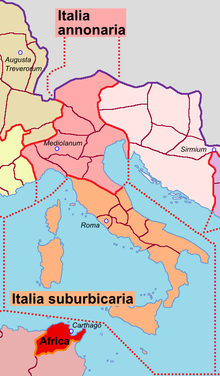
Italia annonaria was a vicariate of the late Roman Empire established by Constantine I (306-337), with Mediolanum (Milan) as its capital.
Under Constantine I, the dioecesis Italiciana was divided into two administrative partitions, or vicariates, each governed by a vicarius: Italia Suburbicaria (Italy "under the government of the urbs", i.e. Rome) and Italia Annonaria.[1] (Italy of the annona - its inhabitants had the obligation to provide the court, the administration and the troops, first allocated in Milan and then in Ravenna, supplies, wine and timber)[2]
In fact, sources of the time, such as the Laterculus Veronensis and the Notitia Dignitatum, attest that de jure Italy continued to be subdivided into a single diocese, the dioecesis Italiciana, which in turn was divided into two vicariates. However, since Italia Annonaria and Italia Suburbicaria were each governed by a vicarius (the highest civil authority of a diocese), they are often improperly called dioceses since de facto they were while not being de jure.
The vicariate of Italia Annonaria included the northern part of the Italian peninsula, Rhaetia and the Cottian Alps. The dividing line between Italia Suburbicaria and Italia Annonaria was placed at the Arno and Esino rivers.[1]
The highest civil authority was the vicarius Italiae, residing in Milan. Italia Annonaria was divided into the following provinces: [[Category:Civil dioceses of the Roman Empire]]
- ^ a b Cfr. La riorganizzazione amministrativa dell'Italia. Costantino, Roma, il Senato e gli equilibri dell'Italia romana entry (in Italian) in the Enciclopedia Treccani
- ^ Cosentino, Salvatore (2008). Storia dell'Italia bizantina, VI-XI secolo: da Giustiniano ai Normanni. Manuali. Bologna: Bononia university press. ISBN 978-88-7395-360-9.